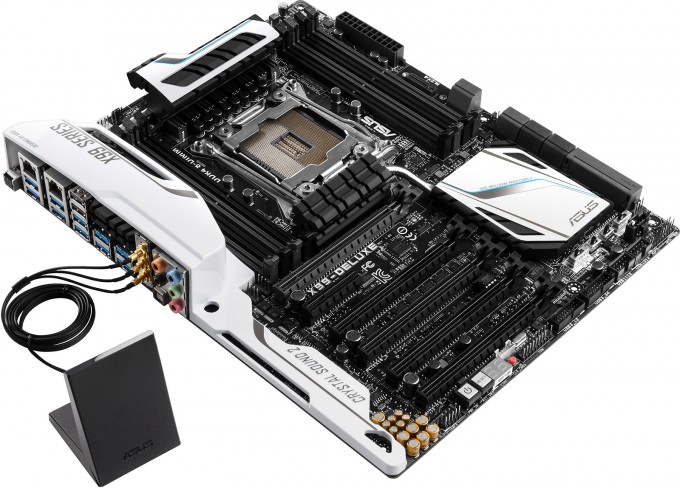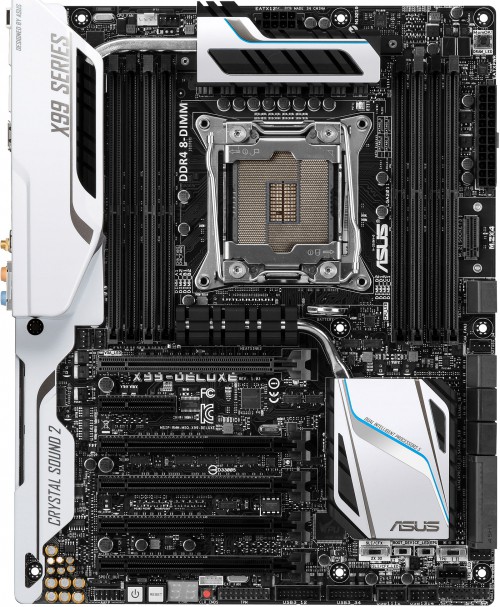- Qualcomm Launches Snapdragon 4 Gen 2 Mobile Platform
- AMD Launches Ryzen PRO 7000 Series Mobile & Desktop Platform
- Intel Launches Sleek Single-Slot Arc Pro A60 Workstation Graphics Card
- NVIDIA Announces Latest Ada Lovelace Additions: GeForce RTX 4060 Ti & RTX 4060
- Maxon Redshift With AMD Radeon GPU Rendering Support Now Available
ASUS X99-DELUXE Motherboard Review

The name “DELUXE” is often used on products that don’t quite deserve it, but when it comes to ASUS’ motherboards, the company makes sure that isn’t the case. Given that, it’s little suprise that the X99-DELUXE does in fact deserve its name, as it doesn’t just offer a slew of features and capabilities, it packs in extras we wouldn’t ever expect.
Page 3 – Performance & Final Thoughts
From a performance perspective, we feel that motherboard benchmarking is almost useless. It’s the motherboard’s job to allow all of the installed hardware to operate at its full potential, so in theory, a $100 option shouldn’t be much (or any) slower than a $300 one. The differences in price instead comes down to the quality of the onboard components and other features.
So why do it at all? It’s because it’s important to make sure that the board we’re dealing with doesn’t lack in one particular area versus the rest. If board A performs 2% slower than board B in PCMark, for example, that’s of no concern to us – benchmark variance is a fact of life. However, if one board consistently performs weaker than the rest, that’s worthy of note – it could suggest that weaker components have been used which do not allow the hardware to operate at its full potential.
Please bear this in mind when perusing our results. Just because a board under-performs in a single test, it doesn’t mean anything in regards to its quality as a whole. Our ultimate goal here is to make sure that each board we test performs as we’d expect across the gamut of scenarios we pit them against.
| Intel LGA2011-v3 Test System | |
| Processor | Intel Core i7-5960X – Octa-Core, 3.00GHz |
| Motherboard | ASUS X99-DELUXE (BIOS: ‘0801’ 09/04/2014) EVGA X99 Micro (BIOS: ‘1.06’ 09/05/2014) GIGABYTE X99-UD4 (BIOS: ‘F10’ 11/24/2014) |
| Memory | Corsair Vengeance DDR4-2800 @ DDR4-2400 16-16-16 |
| Graphics | NVIDIA GeForce GTX 650 Ti (GeForce 340.52 Driver) |
| Audio | Onboard |
| Storage | Kingston HyperX 240GB SSD |
| Power Supply | Corsair HX850W |
| Chassis | Corsair Obsidian 700D Full-Tower |
| Cooling | Noctua NH-U14S Air Cooler |
| Et cetera | Windows 7 Professional 64-bit |
Increasing the BCLK value is one way that vendors could sneak in some higher-than-stock performance numbers, so after letting the test bench sit idle for a couple of minutes, we look at the current BCLK value as according to CPU-Z.
| BCLK Values | Result |
| ASUS X99-DELUXE | 100.1 MHz |
| EVGA X99 Micro | 99.9 MHz |
| GIGABYTE X99-UD4 | 99.9 MHz |
All is kosher. Let’s move on.
General System Performance
To take a look at the “overall” performance of our PC configuration, we rely on dual Futuremark suites: PCMark 8 and 3DMark (2013).
| SPECwpc 1.0 | Media | Financial | Development | Energy | Sciences | General |
| ASUS X99-DELUXE | 3.87 | 4.09 | 3.44 | 4.16 | 4.61 | 5.30 |
| EVGA X99 Micro | 3.64 | 4.03 | 3.12 | 3.79 | 4.37 | 4.36 |
| GIGABYTE X99-UD4 | 4.02 | 4.28 | 3.32 | 3.95 | 4.67 | 4.3 |
| Higher results are better. | ||||||
| PCMark 8 Suite Scores | Home | Work | Creative |
| ASUS X99-DELUXE | 4465 | 5077 | 3474 |
| EVGA X99 Micro | 4294 | 4920 | 3409 |
| GIGABYTE X99-UD4 | 4238 | 4915 | 3579 |
| Higher results are better. | |||
| 3DMark (2013) | 3DMark | Graphics | Physics |
| ASUS X99-DELUXE | 3334 | 3483 | 17247 |
| EVGA X99 Micro | 3299 | 3447 | 16243 |
| GIGABYTE X99-UD4 | 3315 | 3462 | 17200 |
| Fire Strike test. 3DMark results in points; higher is better. | |||
There’s no domination here, which is just what we’d expect. ASUS’ X99-DELUXE does get the obvious edge, however, in both the SPEC and PCMark benchmarks. In 3DMark, both the ASUS and GIGABYTE board might as well be considered identical.
I/O Performance
To properly give the internal SATA 6Gbps and USB 3.0 ports a good workout, we turn to HD Tune and CrystalDiskMark.
| HD Tune Pro 5 | Minimum | Average | Maximum | Latency |
| ASUS X99-DELUXE | 290.5 | 373.0 | 416.6 | 0.093ms |
| EVGA X99 Micro | 247.8 | 332.9 | 367.2 | 0.100ms |
| GIGABYTE X99-UD4 | 249.4 | 350.9 | 394.4 | 0.092ms |
| Min/Avg/Max results in MB/s; higher is better. Latency results in ms; lower is better. | ||||
| CrystalDiskMark | Read Seq. | Read 4K | Write Seq. | Write 4K |
| ASUS X99-DELUXE | 515.3 | 36.68 | 315.4 | 106.8 |
| EVGA X99 Micro | 499.6 | 34.53 | 312.2 | 110.4 |
| GIGABYTE X99-UD4 | 492.4 | 34.27 | 330.7 | 106.3 |
| All results in MB/s. | ||||
| CrystalDiskMark USB 3.0 | Read Seq. | Read 4K | Write Seq. | Write 4K |
| ASUS X99-DELUXE | 432.0 | 27.17 | 286.5 | 59.71 |
| EVGA X99 Micro | 238.2 | 22.84 | 237.8 | 42.83 |
| GIGABYTE X99-UD4 | 242.05 | 22.99 | 240.58 | 41.77 |
| All results in MB/s. | ||||
I don’t know what ASUS is feeding its SATA chipsets, but for the past couple of motherboard generations, its boards have consistently performed better than the others. Will these small differences be noticeable in the real-world? I certainly wouldn’t think so, but like most of the benchmarks on this page, it’s simply interesting to note.
Where ASUS really shines is with the USB 3.0 test, as on its boards, we have the option to enable the UASP protocol. Why that’s not a standard option on the other boards, I’m not quite sure. Again, though, unless you are copying data all day long, the boosted performance might not be that noticeable. Still, I’d rather faster, if given the option.
Rendering & Image Manipulation
Writing files to disk or reading a website doesn’t do much to exercise our CPU, so for that, we turn to a few common scenarios – image editing, video rendering, music conversion, and 3D rendering.
| Adobe Lightroom 5.5 | Result |
| ASUS X99-DELUXE | 435 s |
| EVGA X99 Micro | 464 s |
| GIGABYTE X99-UD4 | 459 s |
| Results in seconds; lower is better. | |
| Adobe Premiere Pro CC | Result |
| ASUS X99-DELUXE | 575 s |
| EVGA X99 Micro | 608 s |
| GIGABYTE X99-UD4 | 577 s |
| Results in seconds; lower is better. | |
| Autodesk 3ds Max 2015 | Result |
| ASUS X99-DELUXE | 674 s |
| EVGA X99 Micro | 723 s |
| GIGABYTE X99-UD4 | 678 s |
| Results in seconds; lower is better. | |
| Cinebench R15 | OpenGL | CPU |
| ASUS X99-DELUXE | 142.05 | 1416 |
| EVGA X99 Micro | 138.31 | 1331 |
| GIGABYTE X99-UD4 | 140.11 | 1397 |
| Higher results are better. | ||
| dBpoweramp R15 | FLAC to MP3 |
| ASUS X99-DELUXE | 463 s |
| EVGA X99 Micro | 491 s |
| GIGABYTE X99-UD4 | 466 s |
| 500 FLAC to 320Kbps MP3. | |
| HandBrake 0.99 | Result |
| ASUS X99-DELUXE | 1880 s |
| EVGA X99 Micro | 1998 s |
| GIGABYTE X99-UD4 | 1880 s |
| Results in seconds; lower is better. | |
| POV-Ray | Single | Multi |
| ASUS X99-DELUXE | 333.95 | 2872.56 |
| EVGA X99 Micro | 320.90 | 2699.90 |
| GIGABYTE X99-UD4 | 333.53 | 2862.15 |
| Higher results are better. | ||
We’re seeing some definite trends here. ASUS’ board in all instances matches or exceeds the performance of the other boards, although both the X99-DELUXE and X99-UD4 from GIGABYTE managed to match the number of seconds in our HandBrake test. Meanwhile, EVGA’s board falls a bit behind.
Sub-system Performance
For memory and CPU testing, we utilize SiSoftware’s Sandra 2015.
| Sandra 2015 (Memory) | Integer | Float |
| ASUS X99-DELUXE | 50.346 GB/s | 51.203 GB/s |
| EVGA X99 Micro | 48.359 GB/s | 48.986 GB/s |
| GIGABYTE X99-UD4 | 51.160 GB/s | 52.395 GB/s |
| Int/Float/Cache results in GB/s; higher is better. | ||
| Sandra 2015 (Arithmetic) | Dhrystone | Whetstone |
| ASUS X99-DELUXE | 318 GIPS | 186 GFLOPS |
| EVGA X99 Micro | 298 GIPS | 176 GFLOPS |
| GIGABYTE X99-UD4 | 311 GIPS | 187 GFLOPS |
| Higher is better. | ||
| Sandra 2015 (Multi-core) | Bandwidth | Latency |
| ASUS X99-DELUXE | 55.67 GB/s | 52.0 ns |
| EVGA X99 Micro | 47.93 GB/s | 53.4 ns |
| GIGABYTE X99-UD4 | 55.71 GB/s | 52.2 ns |
| Bandwidth results; higher is better. Latency results; lower is better. | ||
Once again, EVGA’s board falls a bit behind here (for reasons unknown), but overall, there’s great performance from all three boards here. While faster memory really isn’t important for most people, I admit it’s still nice to see performance peak at about 50GB/s. To put that into perspective, I hit 9.9GB/s on the last memory kit I reviewed seven-years-ago.
Final Thoughts
Thanks to the fact that ASUS’ X99-DELUXE brings so much to the table, it’s not that hard of a board to sum-up. As I mentioned in the intro, I almost feel like this board should be called X99-ULTIMATE, because it offers a lot of what you’d expect, and then piles on a couple of extras you didn’t.
As I also mentioned in the intro, this is a board I should have had a review up for months ago, but due to a number of different factors, it’s been hard to get out the door. I have no great excuse, but that tardiness did lead to a bonus: This is one of the rare motherboards that I’ve had a lot of hands-on experience with.
You see, right at the kick-off of CES (which I remained home during), my PC decided to give me some severe issues, to the point where the computer might as well have been considered dead. After spending far too many hours trying to fix the problem (which, with no exaggeration, included me replacing almost every single part in the rig), I surmised that the motherboard was at fault. Being that CES is a very busy week for us, I had to act fast, and did so by tossing ASUS’ X99-DELUXE in my chassis and getting on with my day.
At this point, I’ve been using the X99-DELUXE, Intel’s Core i7-5960X, and 16GB of Corsair’s Vengeance memory for about a month-and-a-half, and I can honestly say that overall, the experience has been great. That probably won’t come as a big surprise given the accompanying hardware is good, but it’s the overall experience I’m talking about, not just the performance (all I use 8 cores for is compiling apps under Gentoo Linux).
While I’ve dabbled a bit with Ai Suite 3, I admit that I prefer to not have that installed in lieu of just customizing everything – namely fans – in the EFI. Because I like to do so much in the EFI, Ai Suite to me is mostly useful for on-the-fly configuration changes, which I don’t usually need, or monitoring – something I use AIDA64 for (thanks to its robust logging feature).
Overall, the EFI has been great, something I’m sure would have been obvious to anyone who read the EFI section of this review. The lone issue I’ve encountered with the EFI is that sometimes, selecting a drive through the boot selection pop-up (F8 at boot) wouldn’t work. After making my choice, it’ll go into the EFI, forcing me to choose the same option again, at which point it’ll work. I am not sure if this issue is common.
Outside of the fan controller extender card and M.2 capabilities, I tested this board thoroughly, and after having put a lot of time into the board, I can’t say that anything stands out as being unusual. Even though I don’t need Wi-Fi, I tested the included adapter, and it works great (though it helps me that the router is on the very desk I sit at).
Admittedly, the X99-DELUXE is almost “too much board” for me, but I’ve loved using it for as long as I have, and wouldn’t hesitate to recommend it to anyone who wants a truly full-featured offering. The board includes a huge number of SATA and USB ports, supports both M.2 and SATA Express, includes a fan extender (to ultimately offer 10x 4-pin fan headers), wireless (if it’s needed), dual Intel LAN ports, and of course, supports up to 4 GPUs in SLI or CrossFire.
If the X99-DELUXE has an immediate downside, it’s its ~$400 price tag. Given all that the board offers, though, I’m sure its pricing will strike no one as a surprise.
Pros
- Solid board design and layout.
- EFI and Ai Suite 3 software are top-notch solutions.
- Fan Xpert 3 and Q-Fan Control offer awesome fan control.
- Aesthetically pleasing, for what that’s worth.
- An enormous number of SATA and USB ports.
- A tweaker’s board. There are so many on-board toggles and buttons.
- Dual Intel Ethernet ports (can be teamed).
- High-end wireless solution, supports 5GHz.
- Great extras: M.2 mount, M.2 PCIe card, and fan extender.
Cons
- Seems to have everything, until you realize it doesn’t have Thunderbolt.
- The board’s lone x4 PCIe slot is useless unless a single-slot GPU is used.
- Overclocking might be hit-or-miss, but that could be attributed to the X99 platform as a whole.

ASUS X99-DELUXE Motherboard
Support our efforts! With ad revenue at an all-time low for written websites, we're relying more than ever on reader support to help us continue putting so much effort into this type of content. You can support us by becoming a Patron, or by using our Amazon shopping affiliate links listed through our articles. Thanks for your support!







